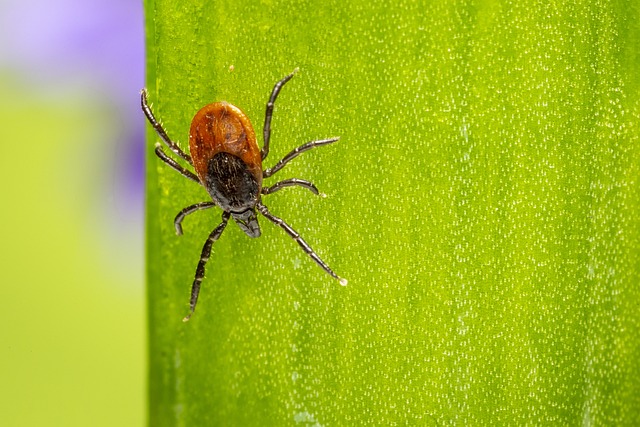Ticks thrive in warm months, preferring grassy and leafy areas, and can survive indoors due to adaptation. To prevent and manage ticks both inside and outside your home, maintain clean outdoor spaces, use insect repellents, vacuum regularly with a HEPA filter, wash bedding and clothes in hot water, and inspect common indoor areas for ticks using fine-toothed combs and tweezers. Regular monitoring and cleaning are crucial for effective indoor tick removal and ensuring safety for children and pets.
In many regions, ticks pose a significant health risk to children and pets due to their harmful bites. Understanding these tiny parasites’ behavior and habitat is the first step towards effective prevention. This article guides you through comprehensive strategies for tick control, focusing on safe methods suitable for homes and families. Learn about indoor tick removal techniques, explore natural repellents, and discover how to monitor and manage ticks in your living space and yard, ensuring a healthier environment for everyone.
Understanding Tick Behavior and Their Habitat
Ticks are most active during warmer months, preferring areas with tall grass and dense foliage where they can easily attach to passing hosts. Understanding their behavior and habitat is crucial for effective tick prevention. These arachnids typically crawl on the ground, waiting for a suitable host to pass by before latching on. They can be found in various outdoor settings, from forests and meadows to suburban backyards. However, it’s not just an outdoor concern; indoor tick removal has become a significant focus as ticks adapt to new environments.
Knowing where ticks lurk helps in implementing targeted control measures. Regularly trimming grass, removing leaf debris, and keeping outdoor areas clean can reduce tick habitats. Additionally, using insect repellents containing DEET or other approved ingredients when spending time outdoors can deter ticks. For indoor spaces, regular vacuuming and washing bedding at high temperatures may help eliminate any accidental indoor tick presence.
Indoor Tick Removal Techniques for Kids and Pets
Removing ticks indoors is a crucial part of tick prevention, especially for children and pets that spend significant time inside. One effective technique is to use a fine-toothed comb designed specifically for tick removal. This tool allows for meticulous inspection and careful removal of embedded ticks. It’s important to go through the fur or hair thoroughly, checking for any hidden ticks, as indoor environments can still harbor these parasites.
Additionally, regular vacuuming can significantly reduce the tick population. Vacuuming floors, furniture, and carpets helps suck up adult ticks and their nymphs. Using a vacuum with a high-efficiency particulate air (HEPA) filter further ensures that any trapped ticks are contained and cannot regurgitate or lay eggs. This method is not only pet-safe but also child-friendly, providing an indoor tick removal strategy that’s easy to incorporate into daily routines.
Natural Repellents and Safe Home Environment
Natural repellents, such as citronella, lavender, and catnip, can be effective in deterring ticks from entering your home. These scents are often used in diffusers or applied topically (always with a carrier oil) to create an unpleasant aroma for ticks, keeping them at bay. Additionally, maintaining a clean and safe home environment is crucial. Regularly vacuum high-risk areas, like grass and shrubbery, to remove any tick eggs or larvae that may have attached themselves to furniture or floors. Wash bedding and clothes in hot water and dry thoroughly to eliminate any potential stowaways.
Creating physical barriers is another layer of protection. Screens on windows and doors prevent ticks from entering your living spaces. Ensure these screens are intact, with no tears or holes, for maximum effectiveness. Indoor tick removal becomes easier when you minimize the risk factors at home. By combining natural deterrents, a clean environment, and robust barriers, you can significantly reduce the chances of tick infestations and keep both children and pets safe.
Monitoring and Managing Ticks in Your Home and Yard
Ticks can be a persistent problem, both indoors and outdoors. To effectively manage them in your home and yard, regular monitoring is key. Start by inspecting common areas where ticks tend to congregate—under furniture, in corners, and along baseboards indoors, as well as shaded areas, tall grass, and bushes in outdoor spaces. Regularly vacuuming floors and surfaces can help remove adult ticks that may have attached themselves to fabrics or carpets.
For indoor tick removal, use a fine-toothed comb to carefully inspect your pets’ fur, focusing on their legs, belly, and tail. If you do find a tick, use tweezers to grasp it as close to the skin as possible and gently pull straight away. Be mindful of avoiding crushing or squeezing the tick’s body, as this can inject saliva into the host, potentially causing an allergic reaction. After removing the tick, clean the bite area with soap and water, and monitor for any signs of irritation or infection.
In light of the above, implementing a multi-faceted approach is key to achieving effective tick prevention and control. By understanding tick behavior, employing safe indoor removal techniques, utilizing natural repellents, and meticulously managing habitats both indoors and outdoors, we can significantly reduce the risk of tick-borne diseases for both children and pets. Remember that proactive measures taken today can prevent lifelong health issues tomorrow. Dive into these methods to create a safer, healthier environment for your loved ones and their four-legged friends.
